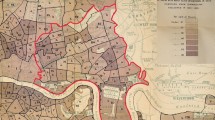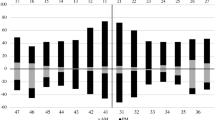Abstract
Contradictory reports on the interreation of caries and attrition concerning their destructive activity at the occlusal surface of teeth required more investigation. Some suggested that the abrasive action of attrition worked against the progress of decay. Others proposed that attrition facilitated the development of caries in dentine exposed due to the dental wear. A comparison of the condition of teeth in western societies from an intermediate stage, with the preceding period characterized by excessive attrition, and with the following period of ongoing reduction of dental wear, might elucidate the mutual relationship. For this reason the almost complete dental assemblage of fifty men, whalers buried during their short sojourn in the Arctic in the 17th and 18th centuries at a Dutch whaling station, and the data of their contemporaries, were evaluated. The results confirmed the proposition that the rise in caries incidence from (pre-) medieval times on, was associated with an ongoing fall of dental attrition. Within this sample of an intermediate phase, one sees that the percentage of carious molars decreases considerably when the degree of dental wear increases. Besides, at the occlusal surface the decay was almost exclusively located in the natural fissures and pits of teeth, not in the exposed dentine due to wear. These findings strongly suggest a competitive relationship between progress of caries and attrition. The best impression of the attrition rate is gained by linkage of degree of dental attrition (i.e. functional age) to age at death. The wide age ranges fitting to the degrees of molar wear make it hazardous to use attrition for age determination.
Similar content being viewed by others
References
Brøndum N., 1981.The jaws and teeth of a medieval population in Svendborg. Ossa, 8: 43–52.
Brothwell D.R., 1981.Digging up bones, 3rd ed. Oxford, Oxford University Press.
Burema L., 1953.De Voeding in Nederland van de Middeleeuwen tot de twintigste Eeuw. Assen, Van Gorcum.
Burt B.A., 1981.The epidemiology of dental caries. In Dental Caries. Aetiology, Pathology and Prevention (ed. L.M. Silverstone, N.W. Johnson, J.M. Hardie and R.A.D. Williams), pp. 18–47, London, the Macmillan Press.
Colyer F., 1922.The teeth of Londoners of the 17th and 18th centuries. The Dental Record, 42: 237–243.
Corbett M.E. &Moore W.J., 1976.Distribution of dental caries in ancient British populations. IV. The 19th century. Caries Research, 10: 401–414.
Dawes J.D. &Magilton J.R., 1980.The Cemetery of St. Helen-on-the-Walls, Aldwark, York, The Ebor Press.
Deerr N., 1950.The history of sugar. London, Chapman and Hall.
Gustafson G., 1950.Age determination of teeth. Journal of the American Dental Association, 41: 45–54.
Hardwick J.L., 1960.The incidence and distribution of caries throughout the ages in relation to the Englishman's diet. British Dental Journal, 108: 9–17.
Helm S. &Prydsö U., 1979.Assessment of age-at-death from mandibular molar attrition in medieval Danes. Scandinavian Journal of Dental Research, 87: 79–90.
Johanson G., 1971.Age determination from human teeth. Odontologisk Revy 22; supplement 21, 59–123.
Kerr N.W., Cross I.F. & Bruce M.F., 1986.Does dental attrition rate remain constant through life? Proceedings of the Anatomical Society of Great Britain and Ireland and the Nederlandse Anatomen Vereninging, July 1986, 26.
Lavelle C.L.B., 1970.Analysis of attrition in adult human molars. Journal of Dental Research, 49: 822–828.
Lovejoy C.O., 1985.Dental wear in the Libben population: its functional pattern and role in the determination of adult skeletal age at death. American Journal of Physical Anthropology, 68: 47–56.
Lunt D.A., 1978.Molar attrition in medieval Danes. In Development, Function and Evolution of teeth (ed. P.M. Butler and K.A. Joysey), pp. 465–482. London, Academic Press.
Maat G.J.R., 1981.Human remains at the Dutch whaling stations on Spitsbergen. A physical anthropological study. In Early European Exploitation of the Northern Atlantic 800–1700 (ed. A.G.F. van Holk, H.K. s'Jacob, and A.A.H.J. Temmingh), pp. 153–201. Groningen, Arctic Centre.
Maat G.J.R., 1984.Dating and rating of Harris's lines. American Journal of Physical Anthropology, 63: 291–299.
Manaker L., 1980.The biologic basis of dental cries. Hagerstown, Harper and Row.
Miles A.E.W., 1963.The dentition in the assessment of individual age in skeletal material. In Dental Anthropology V. (ed. D.R. Brothwell), pp. 191–209. London, Pergamon Press.
Miles A.E.W., 1969.The dentition of Anglo-Saxons. Proceeding of the Royal Society of Medicine, 62: 1311–1315.
Miles A.E.W., 1978.Teeth as an indicator of age in man. In Development, Function and Evolution of Teeth (ed. P.M. Butler and K.A. Joysey), pp. 455–464. London, Academic Press.
Molnar S., 1971.Human tooth wear, tooth function and cultural variability. American Journal of Physical Anthropology, 34: 175–190.
Moore W.J. &Corbett M.E., 1971.The distribution of dental caries in ancient British populations. I. Anglo-Saxon period. Caries Research, 5: 151–168.
Moore W.J. &Corbett M.E., 1971.The distribution of dental caries in ancient British populations. II. Iron age, Romano-British and Mediaeval periods. Caries Rsearch, 7: 139–153.
Moore W.J. &Corbett M.E., 1975.Distribution of dental caries in ancient British populations. III. The 17th century. Caries Research, 9: 163–175.
Murphy T., 1959a.The changing pattern of dentine exposure in human tooth attrition. American Journal of Physical Anthropogy, 17: 167–178.
Murphy T., 1959b.Gradients of dentine exposure in human molar tooth attrition. American Journal of Physical Anthropology, 17: 179–186.
Rosebury Th. &Waugh L.M., 1939.Dental caries among Eskimos of the Kuskokwim area of Alaska. I. Clinical and bacteriological findings. American Journal of Diseases of Children, 57: 871–893.
Rudney J.D., Katz R.V. &Brand J.W., 1983.Interobserver reliability of methods for paleopathological diagnosis of dental caries. American Journal of Physical Anthropology, 62: 243–248.
Scott E.C., 1979a.Principal axis analysis of dental attrition data. American Journal of Physical Anthropology, 51: 203–212.
Scott E.C., 1979b.Dental wear scoring technique. American Journal of Physical Anthropology, 51: 213–218.
Silverstone L.M., Johnson N.W., Hardie J.M. &Williams R.A.D., 1981.Dental caries. Aetiology, Pathology and Prevention. London: the Macmillan Press.
Sjøvold T., 1975.Tables of the combined method for determination of age at death given by Nemeskéri, Harsányi and Acsádi. Anthropol Kzlem, 19: 9–22.
Turner J.G., 1913.Dental caries from a clinical standpoint. Annual report for 1913 of the Royal Dental Hospital. London: John Bale, Sons and Danielsson. Cited from: Colyer (1922).
Van Wijngaarden-Bakker L.H. &Pals J.P., 1981.Life and work in Smeerenburg. The bio-archeological aspects. In Early European Exploitation of the Northern Atlantic 800–1700 (ed. A.G.F. van Holk, H.K. s'Jacob and A.A.H.J. Temmingh), pp. 133–150. Groningen, Arctic Centre.
Wells C., 1964.Bones, Bodies and Disease. London, Thames and Hudson.
Workshop of European Anthropologists, 1980.Recommendations for age and sex diagnosis of skeletons. Journal of Human Evolution, 9: 517–549.
Author information
Authors and Affiliations
Rights and permissions
About this article
Cite this article
Maat, G.J.R., Van der Velde, E.A. The caries-attrition competition. Int. J. Anthropol. 2, 281–292 (1987). https://doi.org/10.1007/BF02443988
Received:
Accepted:
Issue Date:
DOI: https://doi.org/10.1007/BF02443988




